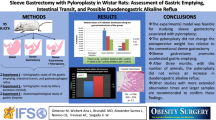Summary
Male Wistar rats were subjected to one of three types of operative reflux procedure that allowed part or all of the duodenal contents to flow back into the stomach through the pylorus, thus producing models of bile reflux alone, pancreaticoduodenal reflux alone, and combined reflux. All surviving animals were killed 50 weeks after surgery and the development of gastric cancer was assessed. No cancer was seen in 16 animals with pancreaticoduodenal reflux or in 32 control animals with gastrotomy, whereas 2/8 animals with bile reflux and 11/29 animals with combined reflux had gastric carcinoma. Compared with the control group, the incidence of carcinoma in animals with bile or combined reflux was significantly higher (P<0.05 andP<0.01 respectively). All carcinomas developed in the antral area near the pylorus. Adenomas were observed only in the groups of animals developing carcinoma and occurred in the same region of the stomach. These results suggest that bile, and not pancreaticoduodenal secretions, is the component of the duodenal contents responsible for the development of gastric carcinoma.
Similar content being viewed by others
References
Busby WF, Shuker DEG, Charnley G, Newberne PM, Tannenbaum SR, Wogan GN (1985) Carcinogenicity in rats of the nitrosated bile acid conjugatesN-nitrosoglycocholic acid andN-nitrosotaurocholic acid. Cancer Res 45:1367–1371
Correa P, Haenzel W, Cuello C, Tannenbaum S, Archer M (1975) A model for gastric cancer epidemiology. Lancet 2:58–60
Dahm K, Werner B (1975) Das Karzinom im operierten Magen. Dtsch Med Wschr 100:1073–1078
Dahm K, Eichen R, Mitschke H (1977) Das Krebsrisiko im Resektionsmagen. Langenbecks Arch Chir 344:71–82
Furihata C, Takezawa R, Matsushima T, Masae T (1987) Potential tumor-promoting activity of bile acids in rat glandular stomach. Jpn J Cancer Res 78:32–39
Heinrich P, Dittrich S, Schuster G, Theuring F, Borkhard H (1985) Das Karzinom am operierten Magen. Z Gesamte Inn Med 40:101–104
Hill M (1985) Normal and pathological microbial flora of the upper gastrointestinal tract. Scand J Gastroenterol [Suppl] 111:1–5
Kobori O, Shimizu T, Maeda M, Atomi Y, Watanabe J, Shoji M, Morioko Y (1984) Enhancing effect of bile and bile acid on stomach tumorigenesis induced byN-methyl-N′-nitro-N-nitrosoguanidine in Wistar rats. J Natl Cancer Inst 73:853–861
Kondo K, Suzuki H, Nagayo T (1984) The influence of gastrojejunal anastomosis on gastric carcinogenesis in rats. Gann 75:362–369
Langhans P, Heger RA, Hohenstein A, Schlake W, Bûnte H (1981) Operation-sequel carcinoma of the stomach. Experimental studies of surgical techniques with or without resection. World J Surg 5:595–605
Mashige F, Osuga T (1976) A simple and sensitive assay of total serum bile acids. Clin Chim Acta 70:79–86
Mason RC (1986) Duodenogastric reflux in rat gastric carcinoma. Br J Surg 73:801–803
Mason RC, Tylor PR, Filipe MI, McColl I (1988) Pancreatcoduodenal secretions and the genesis of gastric stump carcinoma in the rats. Gut 29:830–834
Muscroft TJ, Deane SA, Youngs D, Burdon DW, Keighley MRB (1981) The microflora of the postoperative stomach. Br J Surg 68:560–564
Nishidoi H, Koga S, Kaibara N (1984) Possible role of duodenogastric reflux on the development of remnant gastric carcinoma induced byN-methyl-N′-nitro-N-nitrosoguanidine in rats. J Natl Cancer Inst 72:1431–1435
Orlando R, Welch JP (1981) Carcinoma of the stomach after gastric operation. Am J Surg 141:487–491
Salmon RJ, Laurent M, Thierry JP, (1984) Effect of taurocholic acid feeding on methyl-nitro-N-nitroso-guanidine induced gastric tumors. Cancer Lett 22:315–322
Sano C, Kumashiro R, Saito T, Inokuchi K (1984) Promoting effect of partial gastrectomy on carcinogenesis in the remnant stomach of rats after oral administration ofN-methyl-N′-nitro-N-nitroso-guanidine. Oncology 41:124–128
Schlag P, Boeckler R, Peter M (1982) Nitrite and nitrosoamine in gastric juice: risk factors for gastric cancer? Scand J Gastroenterol 17:145–150
Silverman SJ, Andrews AW (1977) Bile acids: co-mutagenic activity in theSalmonella-mammalian-microsome mutagenecity test. J Natl Cancer Inst 59:1557–1559
Stalsberg H, Taksdal S (1971) Stomach cancer following gastric surgery for benign conditions. Lancet 2:1175–1177
Author information
Authors and Affiliations
Rights and permissions
About this article
Cite this article
Miwa, K., Fujimura, T., Hasegawa, H. et al. Is bile or are pancreaticoduodenal secretions related to gastric carcinogenesis in rats with reflux through the pylorus?. J Cancer Res Clin Oncol 118, 570–574 (1992). https://doi.org/10.1007/BF01211798
Received:
Accepted:
Issue Date:
DOI: https://doi.org/10.1007/BF01211798




